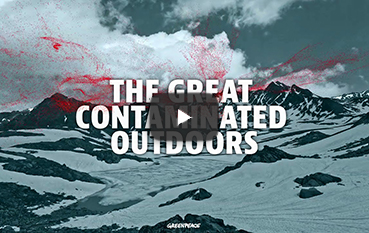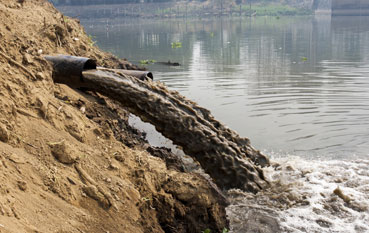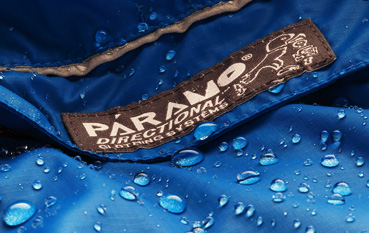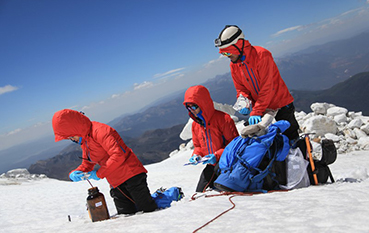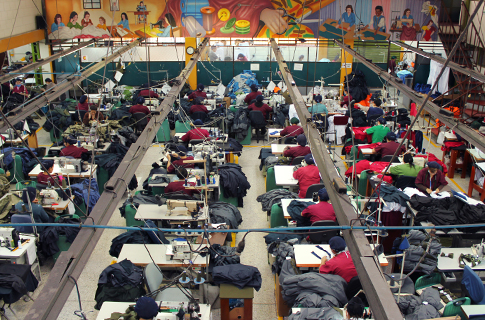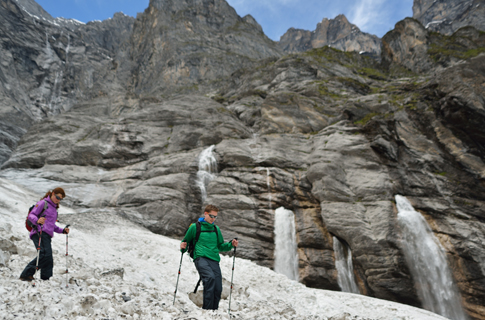WATER-REPELLENCY
WITHOUT HAZARDOUS FLUOROCARBON CHEMICALS (PFCS)
PFCs are commonly used, but at a cost to human health and the environment.
In September 2015, Greenpeace produced the report “Footprints in the Snow” to follow up their earlier publications “Chemistry for Any Weather” which highlighted the continued widespread use of hazardous per- and poly-fluorinated compounds (PFCs) in the outdoor industry.
PFCs are a family of chemicals with very useful water and oil repellent properties, and as such are often applied to outdoor clothing. However, PFCs also have some very undesirable properties; all PFCs are persistent in the environment meaning they cannot be broken down by natural processes, and many members of the PFC family have been shown to be bio-accumulative, meaning that they build up in the bodies of animals. A growing body of scientific research has also linked PFCs to a range of human health issues including damaged immune systems in children1, an increased risk of breast cancer2 and compromised fertility3.
The direct risk to consumers from using PFC-treated clothing is minimal, especially when compared to using a PFC-based spray in your home. However, the manufacturing process for PFC-treated clothing is responsible for release of these substances into local waterways. Because PFCs don’t break down in the environment and can be easily transported in air and water, any release of these chemicals contributes to global background pollution for everyone. By measuring PFC levels in water, snow and ice in Arctic zones and high in mountain ranges, Greenpeace demonstrated in “Footprints in the Snow” that PFCs occur even in the most remote areas. This is why Páramo believe that the ideal solution is to eliminate the use of PFCs in both manufacturing and aftercare.
Páramo has worked with Nikwax to find a safe alternative
The findings of the Greenpeace report came as no surprise to our founder and CEO, Nick Brown. As leader of our sister company Nikwax, he has been an outspoken critic of the use of these chemicals in the outdoor industry. Nikwax has specialised in waterproofing products for use at home in a washing machine, and has never used PFCs because of the high risk of exposure to the consumer.
Nikwax aftercare products are manufactured from raw materials in Nikwax’s own facility in the UK, allowing 100% confidence that PFCs are not used. In contrast, the Páramo supply chain makes use of third party textile mills around the world, and it has always been challenging to know exactly which chemicals are applied to the fabrics we buy.
As a response to that challenge, we have now developed a methodology which allows us to ensure that PFC finishes are not used on our clothing. We do this through a combination of strict specification to our suppliers, rigorous testing for the presence of fluorine, and application of a Nikwax fabric finish which we know we can trust.
Our definition of PFC free
![]() When we say that a Páramo product is PFC free, we mean that no PFCs have been used in its manufacture. However, PFCs are now so widely dispersed in the environment that even the tap water we drink has a low level of background pollution. This level of contamination unfortunately cannot be avoided.
When we say that a Páramo product is PFC free, we mean that no PFCs have been used in its manufacture. However, PFCs are now so widely dispersed in the environment that even the tap water we drink has a low level of background pollution. This level of contamination unfortunately cannot be avoided.
We ensure that third party textile suppliers are not using PFCs on our behalf by testing each batch of fabric we order. PFCs are a large family of different chemicals and testing for each one individually would not be possible. Instead we test the fabrics for the presence of fluorine, the defining element in all PFCs. If our testing shows that elemental fluorine is not present above a certain level, then we can be confident that a PFC treatment has not been applied.
Our current threshold limit for the presence of fluorine on fabric is 0.007% by mass. Any fabrics which do not pass this test are rejected and sent back to the supplier.
This methodology has been applied to all production since 2014, which means that the stock in our warehouse is now guaranteed to be free of PFC-treatment. All new Páramo water-repellent products carry a guaranteed PFC treatment free label.
Páramo's commitment to Detox
In January 2016, in “Leaving Traces”, Greenpeace reported on their testing of 40 outdoor products, nominated by consumers and discovered that only 4 out of the 40 products were free of PFC-treatment. This underlined the fact that most outdoor brands, with the exception of Páramo, are still wedded to the use of PFC-based water repellents as they are nervous that without them, their products would not stand up to the technical requirements of wild conditions. Páramo has been able to establish that high performance waterproofing does not require PFC pollution. Greenpeace scientists wore Páramo clothing when collecting remote area samples and were very satisfied with the protection it gave at altitude and in extreme environments.
In January 2016, Páramo took the significant step of signing up to the Detox commitment. As part of the Greenpeace Detox programme, this commitment lays out the basis for ensuring and demonstrating that hazardous chemicals are excluded from the production of all Páramo products. Páramo is the first Outdoor company to sign up to the Greenpeace Detox commitment. Read more here.
See the list of Páramo approved suppliers here.
1 Grandjean, Phillipe, Elizabeth Wrefrord Anderson, Esben Budtz-Jorgensen, Flemming Nielsen, Kare Molbak, Pal Weihe, and Carsten Heilmann. "Serum Vaccine Antibody Concentrations in Children Exposed to Perfluorinated Compounds." The Journal of the American Medical Association 307 (2012): 391-97. (available online here)
2 Bonefeld-Jorgensen, Eva C., Manhai Long, Rossana Bossi, Pierre Ayotte, Gert Asmund, Tanja Kruger, Mandana Ghisari, Gert Mulvad, Peder Kern, Peter Nzulumiki, and Eric Dewailly. "Perfluorinated compounds are related to breast cancer risk in Greenlandic Inuit: A case control study." Environmental Health 10 (2011): 88. (available online here)
3 Fei, C., J. K. McLaughlin, L. Lipworth, and J. Olsen. "Maternal levels of perfluorinated chemicals and subfecundity." Human Reproduction 24 (2009): 1200-205. (available online here)




